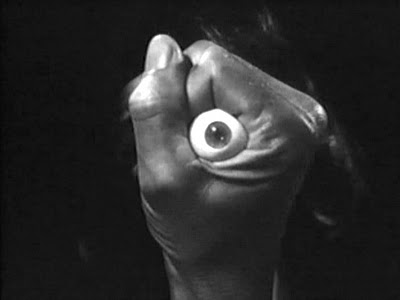
Emotional tears may be uniquely human and are an effective signal of distress in adults. The present study explored whether tears signal distress in younger criers and whether the effect of tears on observers is similar in magnitude across the life span. Participants rated photographs of crying infants, young children, and adults, with tears digitally removed or added. The effectiveness of tears in conveying sadness and eliciting sympathy was greatest for images of adults, intermediate for images of children, and least potent for images of infants. These findings suggest that the signal value of tears varies with the age of the crier. The results may shed light on the functional significance of crying at different stages of human development.
{ Evolutionary Psychology | Continue reading | PDF }
psychology, water |
October 31st, 2011
music |
October 31st, 2011

It’s now been a couple of weeks since Siri debuted as part of Apple’s iPhone 4S. (…)
Siri is hard to copy. For anyone who doesn’t understand voice applications, it’s easy to think that Siri will be easy to copy. It won’t. There are 2 parts to making a successful voice app: the voice rec technology which has improved a lot but is basically a commodity and the app itself, which is a combination of art and artificial intelligence. It’s that 2nd part that’s so tough to replicate and that’s why Apple bought Siri last year. It’s true Google has experience in the voice rec space and doing some simple voice apps but they do not have the personality and AI of Siri and that will be very difficult to copy — especially for a company that doesn’t sit at the intersection of the humanities and technology.
{ Forbes | Continue reading }
related { Apple gets Siri-ous about TV }
economics, robots & ai, technology |
October 31st, 2011

The growing part of the nail is the part still under the skin at the nail’s proximal end under the epidermis, which is the only living part of a nail.
In mammals, the length and growth rate of nails is related to the length of the terminal phalanges (outermost finger bones). Thus, in humans, the nail of the index finger grows faster than that of the little finger; and fingernails grow up to four times faster than toenails.
In humans, nails grow at an average rate of 3 mm (0.12 in) a month (as they are a form of hair). Fingernails require 3 to 6 months to regrow completely, and toenails require 12 to 18 months. Actual growth rate is dependent upon age, gender, season, exercise level, diet, and hereditary factors. Nails grow faster in the summer than in any other season.
Contrary to popular belief, nails do not continue to grow after death.
{ Wikipedia | Continue reading }
health |
October 30th, 2011

The Tim Geoghegan Club, Where everybody knows your name
The Tavistock Hotel in London was the setting for a historic meeting in 1998. Tim Geoghegan of Brooklyn, USA met Tim Geoghegan of Stroud, England. The two men had corresponded via email prior to meeting face-to-face.
Membership in the Tim Geoghegan Club is limited to individuals with the legal name of Timothy Geoghegan, or individuals who wish to become a Tim Geoghegan.
{ Timgeoghegan.com }
photo { Kate Perers }
Onomastics, haha |
October 30th, 2011

{ One of the film’s 210,000 extras | Five years ago, a relatively unknown (and unhinged) director began one of the wildest experiments in film history. Armed with total creative control, he invaded a Ukrainian city, marshaled a cast of thousands and thousands, and constructed a totalitarian society in which the cameras are always rolling and the actors never go home. | GQ | full story }
economics, showbiz |
October 30th, 2011

The zygomatic major, which resides in the cheek, tugs the lips upward, and the orbicularis oculi, which encircles the eye socket, squeezes the outside corners into the shape of a crow’s foot. The entire event is short — typically lasting from two-thirds of a second to four seconds — and those who witness it often respond by mirroring the action, and smiling back.
Other muscles can simulate a smile, but only the peculiar tango of the zygomatic major and the orbicularis oculi produces a genuine expression of positive emotion. Psychologists call this the “Duchenne smile,” and most consider it the sole indicator of true enjoyment. The name is a nod to French anatomist Guillaume Duchenne, who studied emotional expression by stimulating various facial muscles with electrical currents. (…)
Psychological scientists no longer study beheaded rogues — just graduate students, mainly — but they have advanced our understanding of smiles since Duchenne’s discoveries. We now know that genuine smiles may indeed reflect a “sweet soul.” The intensity of a true grin can predict marital happiness, personal well-being, and even longevity. We know that some smiles — Duchenne’s false friends — do not reflect enjoyment at all, but rather a wide range of emotions, including embarrassment, deceit, and grief. We know that variables (age, gender, culture, and social setting, among them) influence the frequency and character of a grin, and what purpose smiles play in the broader scheme of existence. In short, scientists have learned that one of humanity’s simplest expressions is beautifully complex.
{ APS/Observer | Continue reading }
photo { Richard Avedon, William Simon, US Secretary of Treasury, 1976 }
psychology, science |
October 28th, 2011

Most people believe the premature orgasm to be a typical male problem. Women on the other hand are often expected to have difficulties reaching their peak. However, a new study shows that women too can come too fast, sometimes even as often as men. The study was conducted by researcher Serafim Carvalho and his colleagues at the Hospital Magalhães Lemos in Portugal.
Carvalho and his team found 510 Portuguese women between the ages of 18 and 45 years willing to participate. As it turned out, 40 percent sometimes came too fast, 14 percent experienced it on a regular basis and 3.3 percent noted to experience ‘dysfunctions’ as a result of premature orgasms.
{ United Academics | Continue reading }
relationships, science, sex-oriented |
October 28th, 2011

How listening to an iPod shrinks your sense of personal space
Positive music played over headphones (but not speakers) had the effect of shrinking the participants’ sense of personal space, so that the approaching experimenter could walk closer to them before they (the participant) felt uncomfortable. On the other hand, negative music played over speakers (but not headphones) expanded the participants’ personal space, so they felt uncomfortable when the approaching experimenter was further away. These effects were most pronounced in the participants who afterwards reported that they’d been affected emotionally by the music to a greater degree.
{ BPS | Continue reading }
music, psychology, relationships |
October 28th, 2011

This article examines the role of storytelling in the process of making sense of the financial crisis.
Taken for granted assumptions were suddenly open to question. Financial products and practices that were once assumed to be sustainable sources of economic growth and prosperity swiftly became de-legitimized. Highly respected individuals and institutions (bankers, regulators) suddenly became widely detested.
The moral stories crafted during a public hearing in the UK that was designed to uncover ‘what (or who) went wrong’ during the recent financial crisis are examined. Micro-linguistic tools were used to build different emplotments of the ‘story’ of the financial crisis and paint a picture of the key characters, for example as ‘villains’ or ‘victims.’ The stories told by the bankers had assigned responsibility for the crisis and what should be done about it. These stories shaped both public opinion and policy responses.
The study illustrates when a crisis of sensemaking occurs, and the dominant and well-established storyline is no longer plausible a new story must be crafted to make sense of what happened and why.
The plot and characters of a story start to form a meaningful story only when discursive devices (linguistic styles, phrases, tropes and figures of speech) build up a moral landscape within which the events unfold.
{ Bankers in the dock: Moral storytelling in action | SAGE | full article }
economics, ideas |
October 28th, 2011

Finding the right problem is half the solution
Everyone knows that finding a good problem is the key to research, yet no one teaches us how to do that. Engineering education is based on the presumption that there exists a predefined problem worthy of a solution. If only it were so!
After many years of managing research, I’m still not sure how to find good problems. Often I discovered that good problems were obvious only in retrospect, and even then I was sometimes proved wrong years later. Nonetheless, I did observe that there were some people who regularly found good problems, while others never seemed to be working along fruitful paths. So there must be something to be said about ways to go about this.
{ IEEE Spectrum | Continue reading }
photo { Yosuke Yajima }
ideas |
October 28th, 2011

If you want to know why the Beastie Boys album Paul’s Boutique includes a sample from the White Album, while no subsequent piece of music has ever legally included a sample from the Beatles, the answer is copyright law. When sampling was new, the recording industry didn’t realize it could make money off samples, and they weren’t covered by copyright. Then the age of hip-hop mega-sellers arrived, and the holders of rights to pop classics discovered they could make more money on the remix than the original track ever pulled down.
The results of this licensing orgy are that it’s now almost impossible for a DJ or producer to license a sample for a reasonable amount of money. The odds of getting every artist sampled to OK the use of their work, and the resulting fees, preclude music like this from ever being sold; that’s why artists like Girl Talk simply give it away.
Legitmix, a track licensing platform, is here to cut the Gordian Knot of making tracks available to other musicians while getting artists paid for the use of their music. Its core innovation is the replacement of the old process — lawyers, contracts, permissions — with a straightforward API.
{ Mims’s Bits | Continue reading }
related { The key ingredient for a hit pop song? Reproductive messages. }
economics, music |
October 28th, 2011

Venus and Adonis is a poem by William Shakespeare, written in 1592–1593, with a plot based on passages from Ovid’s Metamorphoses. It is a complex, kaleidoscopic work, using constantly shifting tone and perspective to present contrasting views of the nature of love.
The poem contains what may be Shakespeare’s most graphic depiction of sexual excitement.
Venus and Adonis comes from the 1567 translation by Arthur Golding of Ovid’s Metamorphoses, Book 10. Ovid told of how Venus took the beautiful Adonis as her first mortal lover. They were long-time companions, with the goddess hunting alongside her lover. She warns him of the tale of Atalanta and Hippomenes to dissuade him from hunting dangerous animals; he disregards the warning, and is killed by a boar. Shakespeare developed this basic narrative into a poem of 1,194 lines. His chief innovation was to make Adonis refuse Venus’s offer of herself.
{ Wikipedia | Continue reading }
And at his look she flatly falleth down
For looks kill love, and love by looks reviveth;
A smile recures the wounding of a frown;
But blessed bankrupt, that by love so thriveth!
The silly boy, believing she is dead
Claps her pale cheek, till clapping makes it red;
(…)
He wrings her nose, he strikes her on the cheeks,
He bends her fingers, holds her pulses hard,
He chafes her lips; a thousand ways he seeks
To mend the hurt that his unkindness marr’d:
He kisses her; and she, by her good will,
Will never rise, so he will kiss her still.
{ Venus and Adonis | full text }
books, poetry |
October 28th, 2011
Linguistics, science |
October 28th, 2011

In Italy, all cargo containers carrying scrap metal get checked for radiation, by hand, before they’re allowed off the docks. At Voltri, this job falls to Montagna, a 49-year-old independent consultant certified as an expert in radiation detection by the Italian government. By the time he arrived that morning, longshoremen had gathered eleven 20-foot-long, 8-foot-wide containers from across the terminal, relying on manifests to determine which ones needed to be scanned. The boxes were lined up in two neat rows near the terminal’s entrance. (…)
He plugged in a heavy sensor wand and set the device on the ground 20 yards away from the containers. The Model 3 emits a high-pitched beep every time it detects a radioactive particle; Montagna turned it on, and the meter’s needle swung hard to the right, burying itself past the maximum reading of 500,000 counts per minute. Instead of its usual staccato chirps, the machine was whining continuously and frantically. (…)
Montagna realized that one of the containers in front of him held a lethal secret. But was that secret merely a slow-motion radioactive industrial accident—or a bomb, one that could decimate the Italian city’s entire 15-mile waterfront? Montagna ran back to his car to get a less sensitive detector. He didn’t give much thought to protection; at those radiation levels, he would have needed lead armor 5 inches thick to stand within a couple of feet of the source for very long.
Montagna took the new meter and walked up to the sealed boxes, circling each one in turn. Halfway down the second row, a crimson 20-footer with “TGHU 307703 0 22G1″ emblazoned in white on its side jerked the dials. As he passed a few feet from the box’s left side, Montagna was absorbing radiation equivalent to six chest x-rays per minute.
There are millions of containers just like TGHU 307703 0 22G1. The only thing that distinguished it from the steel boxes stacked in your local port or hitched to a truck one lane over during your morning commute—besides radiation a million times above normal background levels—was the painted-on identification number. (…)
Under the right conditions, just 20 milligrams of cesium-137—roughly the amount found in gadgets that hospitals use to calibrate their radiation therapy equipment—could contaminate 40 city blocks. (…)
The team then brought in one of the most sensitive portable detectors on the market, an $80,000 Ortec HPGe Detective DX-100T.
{ Wired | Continue reading }
spy & security, technology, uh oh |
October 28th, 2011
visual design |
October 28th, 2011

A University of Maastricht study found that eating at least four small meals daily reduces obesity risk by 45 percent. This Dutch study also found that people who skip breakfast are five times as likely to become obese as regular breakfasters.
Yet a University of Ottawa study found that eating many small meals doesn’t promote weight loss. So did a French National Center for Scientific Research study, which trashed grazing: “Epidemiological studies which have suggested that nibbling is associated with leanness are extremely vulnerable to methodological errors,” its authors warn.
A UC Berkeley study found that “alternate-day fasting” — feasting one day, fasting the next, ad infinitum — might decrease the risk of heart disease and cancer.
Researching the effects of meal frequency is notoriously tricky, because it involves so many variables: nutritional content, time of day, exercise, genetics. So the scientific jury is still out.
“There is no biological reason for eating three meals a day,” says Yale University history professor Paul Freedman.
{ AlterNet | Continue reading }
photo { Rasmus Mogensen }
food, drinks, restaurants, health, science |
October 27th, 2011
art, asia |
October 27th, 2011

Although procrastination is conceived as a problem by the scientific community, there is not much consensus regarding the nature of this issue. Scholars have been arguing for decades whether procrastination is a rather uncontrollable phenomenon that happens merely on a whim or if it can be classified as arousal, avoidant, or decisional, for example. In any event, statistics since the early 1970′s have consistently shown an alarming prevalence of procrastination reaching over 70% among college students and starting at 20% in the general population. (…)
The Rational Emotive Behavior Therapy (REBT) website offers a worthwhile guide to identifying and dealing with procrastination.
{ BrainBlogger | Continue reading }
guide, psychology |
October 27th, 2011

Whether you were happy with life as a teenager could be down to a certain gene, says a new study.
In a large study of American adolescents, teens who carried the long form of the 5HTTLPR locus were more likely to say they were satisfied or very satisified with their lives (at age 18 to 26). People with two long variants were the most cheerful, with short/long carriers in the middle and short/short being the least so. (…)
This study is the latest in a long, long line of attempts to correlate 5HTTLPR with happiness, depression, stress and so on. A few months ago I discussed the history of this busy little gene and covered a meta-analysis of no fewer than 54 papers which claimed that there was indeed a link, with the short allele increasing the risk of depression in response to stressful events.
However many studies failed to find one, and worryingly the three largest studies were all negative which is a classic tell-tale sign of publication bias.
{ Neuroskeptic | Continue reading }
photos { 1. Erica Segovia | 2. Maggie Lochtenberg }
genes, kids, photogs |
October 27th, 2011





















